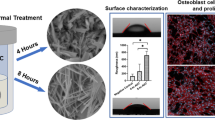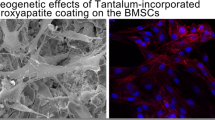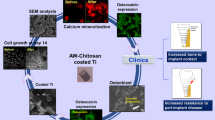Abstract
Patients diagnosed with osteoporosis who undergo dental implantation procedures frequently encounter challenges related to impaired and delayed fusion with the bone, thereby leading to an elevated failure rate. To address this issue, it is reasonable to conceptualize the development of a dental implant coating that exhibits optimized surface properties and the capacity to deliver anti-osteoporosis pharmaceutical agents. Nonetheless, the literature provides limited documentation on the most suitable coating framework. In this study, a novel titanium implant coating system was successfully devised, comprising a biomimetic hierarchical topographical structure referred to as the bone resorption lacunae-like surface (RLS) and embedded mesoporous silica nanoparticles (MSNs) serving as a platform for drug administration. Scanning electron microscopy images revealed that the RLS surface comprised micro-sized craters (10–70 μm) and interconnected nanopores (50–220 nm). After spin coating and 600 ℃ annealing treatment, the MSNs were embedded and firmly anchored within the interconnected nanopores. Release tests demonstrated sustained release of raloxifene (Ral) from the RLS-MSNs-Ral samples for over 11 days. Furthermore, the RLS-MSNs-Ral sample exhibited enhanced adhesion, proliferation, alkaline phosphatase activity, mineralization, and osteogenic gene expression in MG63 osteoblast-like cells. This study presents a promising titanium implant coating strategy to enhance osseointegration in osteoporotic conditions.






Similar content being viewed by others
Explore related subjects
Discover the latest articles, news and stories from top researchers in related subjects.Data availability
Not applicable.
Code availability
Not applicable.
References
Meffert RM, Langer B, Fritz ME (1992) Dental implants: a review. J Periodontol 63:859–870. https://doi.org/10.1902/jop.1992.63.11.859
Compston JE, McClung MR, Leslie WD (2019) Osteoporosis. Lancet 393:364–376. https://doi.org/10.1016/S0140-6736(18)32112-3
Wang L, Yu W, Yin X et al (2021) Prevalence of osteoporosis and fracture in China: the China osteoporosis prevalence study. JAMA Netw Open 4:e2121106. https://doi.org/10.1001/jamanetworkopen.2021.21106
De Medeiros FCFL, Kudo GAH, Leme BG et al (2018) Dental implants in patients with osteoporosis: a systematic review with meta-analysis. Int J Oral Maxillofac Surg 47:480–491. https://doi.org/10.1016/j.ijom.2017.05.021
Dereka X, Calciolari E, Donos N, Mardas N (2018) Osseointegration in osteoporotic-like condition: a systematic review of preclinical studies. J Periodontal Res 53:933–940. https://doi.org/10.1111/jre.12566
Shao H, Ma M, Wang Q et al (2022) Advances in the superhydrophilicity-modified titanium surfaces with antibacterial and pro-osteogenesis properties: a review. Front Bioeng Biotechnol 10:1000401. https://doi.org/10.3389/fbioe.2022.1000401
He X, Yamada M, Watanabe J et al (2022) Titanium nanotopography induces osteocyte lacunar-canalicular networks to strengthen osseointegration. Acta Biomater 151:613–627. https://doi.org/10.1016/j.actbio.2022.08.023
Souza JCM, Sordi MB, Kanazawa M et al (2019) Nano-scale modification of titanium implant surfaces to enhance osseointegration. Acta Biomater 94:112–131. https://doi.org/10.1016/j.actbio.2019.05.045
Siqueira R, Ferreira JA, Rizzante FAP et al (2021) Hydrophilic titanium surface modulates early stages of osseointegration in osteoporosis. J Periodontal Res 56:351–362. https://doi.org/10.1111/jre.12827
Peter B, Pioletti DP, Laib S et al (2005) Calcium phosphate drug delivery system: influence of local zoledronate release on bone implant osteointegration. Bone 36:52–60. https://doi.org/10.1016/j.bone.2004.10.004
Harmankaya N, Karlsson J, Palmquist A et al (2013) Raloxifene and alendronate containing thin mesoporous titanium oxide films improve implant fixation to bone. Acta Biomater 9:7064–7073. https://doi.org/10.1016/j.actbio.2013.02.040
Barik A, Chakravorty N (2020) Targeted drug delivery from titanium implants: a review of challenges and approaches. Adv Exp Med Biol 1251:1–17. https://doi.org/10.1007/5584_2019_447
Agholme F, Andersson T, Tengvall P, Aspenberg P (2012) Local bisphosphonate release versus hydroxyapatite coating for stainless steel screw fixation in rat tibiae. J Mater Sci Mater Med 23:743–752. https://doi.org/10.1007/s10856-011-4539-5
Alghamdi HS, Bosco R, Both SK et al (2014) Synergistic effects of bisphosphonate and calcium phosphate nanoparticles on peri-implant bone responses in osteoporotic rats. Biomaterials 35:5482–5490. https://doi.org/10.1016/j.biomaterials.2014.03.069
Yifei Gu, Wei L, Zhang Z et al (2022) BMP-2 incorporated biomimetic CaP coating functionalized 3D printed Ti6Al4V scaffold induces ectopic bone formation in a dog model. Mater Des 215:110443. https://doi.org/10.1016/j.matdes.2023.111849
Huo FJ, Guo WH, Wu H et al (2018) Fabrication of biomimetic resorption lacunae-like structure on titanium surface and its osteoblast responses. Appl Surf Sci 436:11–21. https://doi.org/10.1016/j.apsusc.2017.11.282
Davies JE (2007) Bone bonding at natural and biomaterial surfaces. Biomaterials 28:5058–5067. https://doi.org/10.1016/j.biomaterials.2007.07.049
Teitelbaum SL (2000) Bone resorption by osteoclasts. Science 289:1504–1508. https://doi.org/10.1126/science.289.5484.1504
Hefti T, Frischherz M, Spencer ND, Hall H, Schlottig F (2010) A comparison of osteoclast resorption pits on bone with titanium and zirconia surfaces. Biomaterials 31:7321–7331. https://doi.org/10.1016/j.biomaterials.2010.06.009
Goff MG, Slyfield CR, Kummari SR et al (2012) Three-dimensional characterization of resorption cavity size and location in human vertebral trabecular bone. Bone 51:28–37. https://doi.org/10.1016/j.bone.2012.03.028
Kankala RK, Han YH, Na J et al (2020) Nanoarchitectured structure and surface biofunctionality of mesoporous silica nanoparticles. Adv Mater 32:e1907035. https://doi.org/10.1002/adma.201907035
Slowing II, Trewyn BG, Giri S, Lin VSY (2007) Mesoporous silica nanoparticles for drug delivery and biosensing applications. Adv Funct Mater 17:1225–1236. https://doi.org/10.1002/adfm.200601191
Tang FQ, Li LL, Chen D (2012) Mesoporous silica nanoparticles: synthesis, biocompatibility and drug delivery. Adv Mater 24:1504–1534. https://doi.org/10.1002/adma.201104763
Abu-Dief AM, Alsehli M, Al-Enizi A, Nafady A (2022) Recent advances in mesoporous silica nanoparticles for targeted drug delivery applications. Curr Drug Deliv 19:436–450. https://doi.org/10.2174/1567201818666210708123007
Fang L, Zhou H, Cheng L, Wang Y, Liu F, Wang S (2023) The application of mesoporous silica nanoparticles as a drug delivery vehicle in oral disease treatment. Front Cell Infect Microbiol 13:1124411. https://doi.org/10.3389/fcimb.2023.1124411
Cao J, Yang DL, Wang D, Wang JX (2022) Spray-drying-assisted fabrication of CaF2/SiO2 nanoclusters for dental restorative composites. Dent Mater 38:835–847. https://doi.org/10.1016/j.dental.2022.04.007
Peng C, Zhang S, Sun Z, Ren L, Yang K (2018) Effect of annealing temperature on mechanical and antibacterial properties of Cu-bearing titanium alloy and its preliminary study of antibacterial mechanism. Mater Sci Eng C Mater Biol Appl 93:495–504. https://doi.org/10.1016/j.msec.2018.08.018
Ha J, Kim J, Jeong C et al (2022) Effect of follow-up raloxifene therapy after denosumab discontinuation in postmenopausal women. Osteoporos Int 33:1591–1599. https://doi.org/10.1007/s00198-022-06388-w
Fugere P, Scheele WH, Shah A, Strack TR, Glant MD, Jolly E (2000) Uterine effects of raloxifene in comparison with continuous-combined hormone replacement therapy in postmenopausal women. Am J Obstet Gynecol 182:568–574. https://doi.org/10.1067/mob.2000.104768
Chen D, Li LL, Tang FQ, Qi SO (2009) Facile and scalable synthesis of tailored silica “nanorattle” structures. Adv Mater 21:3804–3807. https://doi.org/10.1002/adma.200900599
Chen TL (2004) Inhibition of growth and differentiation of osteoprogenitors in mouse bone marrow stromal cell cultures by increased donor age and glucocorticoid treatment. Bone 35:83–95. https://doi.org/10.1016/j.bone.2004.03.019
Vallet-Regi M (2006) Ordered mesoporous materials in the context of drug delivery systems and bone tissue engineering. Chemistry 12:5934–5943. https://doi.org/10.1002/chem.200600226
Feng W, Nie W, He C et al (2014) Effect of pH-responsive alginate/chitosan multilayers coating on delivery efficiency, cellular uptake and biodistribution of mesoporous silica nanoparticles based nanocarriers. ACS Appl Mater Interfaces 6:8447–8460. https://doi.org/10.1021/am501337s
Feng W, Zhou X, He C et al (2013) Polyelectrolyte multilayer functionalized mesoporous silica nanoparticles for pH-responsive drug delivery: layer thickness-dependent release profiles and biocompatibility. J Mater Chem B 1:5886–5898. https://doi.org/10.1039/c3tb21193b
Pattanayak DK, Yamaguchi S, Matsushita T, Kokubo T (2011) Effect of heat treatments on apatite-forming ability of NaOH- and HCl-treated titanium metal. J Mater Sci Mater Med 22:273–278. https://doi.org/10.1007/s10856-010-4218-y
Eriksson C, Nygren H, Ohlson K (2004) Implantation of hydrophilic and hydrophobic titanium discs in rat tibia: cellular reactions on the surfaces during the first 3 weeks in bone. Biomaterials 25:4759–4766. https://doi.org/10.1016/j.biomaterials.2003.12.006
Yao X, Song Y, Jiang L (2011) Applications of bio-inspired special wettable surfaces. Adv Mater 23:719–734. https://doi.org/10.1002/adma.201002689
Gittens RA, Scheideler L, Rupp F et al (2014) A review on the wettability of dental implant surfaces II: biological and clinical aspects. Acta Biomater 10:2907–2918. https://doi.org/10.1016/j.actbio.2014.03.032
Ferraris S, Bobbio A, Miola M, Spriano S (2015) Micro- and nano-textured, hydrophilic and bioactive titanium dental implants. Surf Coat Technol 276:374–383. https://doi.org/10.1016/j.surfcoat.2015.06.042
Wenzel RN (1936) Resistance of solid surfaces to wetting by water. Ind Eng Chem 28:988–994. https://doi.org/10.1021/ie50320a024
Varshosaz J, Minaiyan M, Dayyani L (2018) Poly(methyl vinyl ether-co-maleic acid) for enhancement of solubility, oral bioavailability and anti-osteoporotic effects of raloxifene hydrochloride. Eur J Pharm Sci 112:195–206. https://doi.org/10.1016/j.ejps.2017.11.026
Saini D, Fazil M, Ali MM, Baboota S, Ali J (2015) Formulation, development and optimization of raloxifene-loaded chitosan nanoparticles for treatment of osteoporosis. Drug Deliv 22:823–836. https://doi.org/10.3109/10717544.2014.900153
Wang K, Jin H, Song Q, Huo J, Zhang J, Li P (2021) Titanium dioxide nanotubes as drug carriers for infection control and osteogenesis of bone implants. Drug Deliv Transl Res 11:1456–1474. https://doi.org/10.1007/s13346-021-00980-z
Taranta A, Brama M, Teti A et al (2002) The selective estrogen receptor modulator raloxifene regulates osteoclast and osteoblast activity in vitro. Bone 30:368–376. https://doi.org/10.1016/s8756-3282(01)00685-8
Liu T, Li L, Teng X et al (2011) Single and repeated dose toxicity of mesoporous hollow silica nanoparticles in intravenously exposed mice. Biomaterials 32:1657–1668. https://doi.org/10.1016/j.biomaterials.2010.10.035
Sengottuvelan A, Balasubramanian P, Will J, Boccaccini AR (2017) Bioactivation of titanium dioxide scaffolds by ALP-functionalization. Bioact Mater 2:108–115. https://doi.org/10.1016/j.bioactmat.2017.02.004
Zhang XY, Liu H, Li L et al (2022) Promoting osteointegration effect of Cu-alloyed titanium in ovariectomized rats. Regen Biomater 9:rbac011. https://doi.org/10.1093/rb/rbac011
Acknowledgements
This work was financially supported by the Sichuan Science and Technology Program (Grant Number 2022YFS0283), the National Natural Science Foundation of China (Grant Number 81970968, 32271415), the National Key R&D Program of China (Grant Number 2022YFA1104400), and the Research and Develop Program, West China Hospital of Stomatology Sichuan University (Grant Number RD-02-202113).
Author information
Authors and Affiliations
Contributions
FH was involved in the conceptualization, methodology, investigation, writing—original draft, and funding acquisition. YW contributed to the methodology, investigation, and resources. SZ contributed to the resources and funding acquisition. XT and XS contributed to the resources. WT contributed to the supervision, conceptualization, and funding acquisition. LX assisted in the supervision, conceptualization, writing—review and editing, and funding acquisition.
Corresponding authors
Ethics declarations
Conflict of interest
The authors declare that they have no known competing financial interests or personal relationships that could have appeared to influence the work reported in this paper.
Ethical approval
Not applicable.
Additional information
Handling Editor: Maude Jimenez.
Publisher's Note
Springer Nature remains neutral with regard to jurisdictional claims in published maps and institutional affiliations.
Rights and permissions
Springer Nature or its licensor (e.g. a society or other partner) holds exclusive rights to this article under a publishing agreement with the author(s) or other rightsholder(s); author self-archiving of the accepted manuscript version of this article is solely governed by the terms of such publishing agreement and applicable law.
About this article
Cite this article
Huo, F., Wang, Y., Zhang, S. et al. Preparation of raloxifene-delivery MSNs-embedded biomimetic coating on titanium and its in vitro evaluation for enhanced osteogenesis. J Mater Sci 59, 593–608 (2024). https://doi.org/10.1007/s10853-023-09193-w
Received:
Accepted:
Published:
Issue Date:
DOI: https://doi.org/10.1007/s10853-023-09193-w




